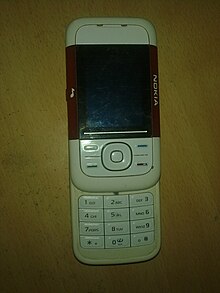
The S60 Platform is a discontinued software platform for smartphones that runs on top of the Symbian operating system. It was created by Nokia based on the 'Pearl' user interface from Symbian Ltd. It was introduced at COMDEX in November 2001 and first shipped with the Nokia 7650 smartphone. The platform has since seen 5 updated editions. Series 60 was renamed to S60 in November 2005.

The Nokia 3410 is a mobile phone made by Nokia, the successor of the popular Nokia 3310. It was announced at CEBIT on 12 March 2002. The 3410 was one of the first Java phones by Nokia, as well as being one of the earliest mobile phones outside Japan to feature 3D graphics and an image editor. The Nokia 3410 was never released in the Asia-Pacific region, likely due to variants of the 3310 such as the Nokia 3315 and 3350 which had similar hardware and keypad layout, as well as Nokia observing tetraphobia in Asian markets where the number four is viewed as unlucky.

The Nokia 6230 is a mobile phone based on the Nokia Series 40 platform. It was announced on 28 October 2003 and released in February 2004.

The Nokia 3200 is a mobile phone by Nokia, part of the Nokia Expression (youth) series and announced on 12 September 2003. It is based on the Nokia Series 40 platform. The phone is an update of the Nokia 3100, while adding features from the Nokia 7250i and 6610i. The phone's feature set was very similar to the 7250i and 6610i, but featured different software and firmware installed, and was sold at a lower price than the 7250i or 6610i. Of the three phones, the 3200 was mainly targeted towards the youth market, the 7250i towards fashion-conscious users, and the 6610i towards business users. Core features include an XHTML browser, alarm clock, flashlight, EDGE and FM stereo radio with a 128 × 128 12-bit (4096) color screen. The phone has multimedia features such as picture and text messaging. Features carried over from the Nokia 3100 include ringer profiles and voice memo capability. It also has Java games. The phone has an extensive calendar with a lunar calendar. The flashlight is located under the phone and can be activated by holding the "star" (asterisk) key. The camera is on the back of the phone. The 3200 can also play both polyphonic and monophonic ringtones. The phone's visual interface in its menu system is similar to that of the Nokia 3100, using large, static icons rather than animated ones.
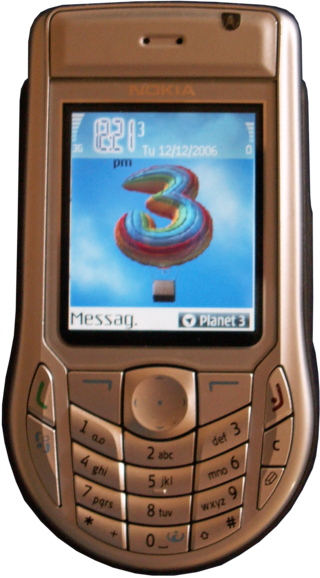
The Nokia 6630 is a 3G mobile phone announced by Nokia on 14 June 2004 and released in November. It runs on Symbian OS 8.0a. Codenamed Charlie during development, it is an evolution of the 6600 and 6620 smartphones, supporting tri-band GSM.
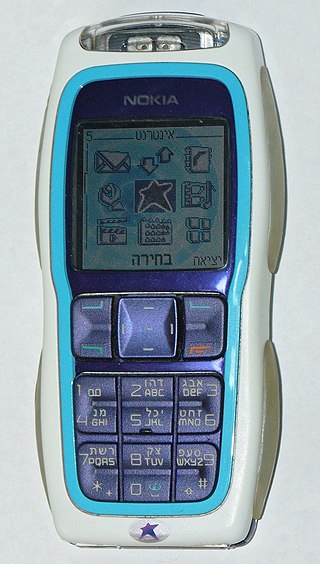
The Nokia 3220 is a GSM, Series 40 mobile phone from Nokia. The Nokia 3220 was introduced on 31 May 2004 as a "fun" device with LED lights and Xpress-on covers. It was the first entry-level phone that offered full access to the Internet, with an XHTML browser and POP3/IMAP email client. The tri-band camera phone uses GPRS and EDGE for its internet connections.
Visual radio is a generic term for adding visuals to audio radio broadcasts. Visual Radio is also a trademark for a Nokia product which delivers interactive FM radio over a data connection.
Nokia Series 40, often shortened as S40, is a software platform and application user interface (UI) software on Nokia's broad range of mid-tier feature phones, as well as on some of the Vertu line of luxury phones. It was one of the world's most widely used mobile phone platforms and found in hundreds of millions of devices. Nokia announced on 25 January 2012 that the company has sold over 1.5 billion Series 40 devices. It was not used for smartphones, with Nokia turning first to Symbian, then in 2012–2017 to Windows Phone, and most recently Android. However, in 2012 and 2013, several Series 40 phones from the Asha line, such as the 308, 309 and 311, were advertised as "smartphones" although they do not actually support smartphone features like multitasking or a fully fledged HTML browser.

The Nokia 7710 is a mobile phone developed by Nokia and announced on 2 November 2004. It was the first Nokia device with a touchscreen, and first Nokia branded device with 2:1 aspect ratio display. The 7710 is based on the Nokia 7700 which was never released. It is Nokia's only smartphone to run the Series 90 interface atop Symbian OS v7.0s.

The Nokia 6233 phone made by Nokia is the successor to the Nokia 6230i. It is a 3G/GSM/WCDMA mobile phone that runs the Series 40 3rd Edition, Feature Pack 1 UI on the Nokia operating system.

XpressMusic was a brand name for a line of Nokia mobile phones that were specially designed for music playback. All of the XpressMusic handsets came with expandable MicroSD memory slots and dedicated music keys, so these phones could also be used as MP3 players. The XpressMusic range was launched in September 2006 to compete with the Walkman brand series from Sony Ericsson. Except the Nokia 3250, all XpressMusic models were marketed with the 5000 series prefixes.
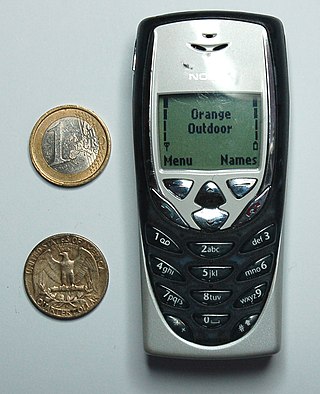
The Nokia 8310 is a mobile phone manufactured by Nokia between 2001 and 2002. Belonging to the 8000 series, the handset was a member of Nokia's flagship premium 'candybar' variety, and retailed for a price in excess of £400 on launch after its announcement at CEBIT in March 2001. Incorporating Nokia's trademark menu system and GUI with a white backlight, the device was easy to operate, yet contained advanced premium features not normally found on handsets of the time, such as infrared, a fully functional calendar, and was the first Nokia phone to support GPRS and an FM Radio. It was also the lightest Nokia phone to feature a polyphonic startup sound, despite not having polyphonic ringtones built into the phone, possibly due to the muffled sound.

Nokia 5300 XpressMusic is a slider mobile phone by Nokia, part of the XpressMusic range. It was introduced on 26 September 2006 and released at the end of that year. It runs on Nokia Series 40 3rd Edition FP2.

The Nokia 5310 is an XpressMusic mobile phone, introduced by Nokia on 29 August 2007 and released in the fourth quarter of 2007. It is less than a centimeter thick and is available with blue, red, purple, pink, orange, silver or black trim, the main body also being available in grey, black or white. It features many music specific features as well as a 2.0-megapixel camera. At 9.9 mm thick, it is one of few mobile phones measuring less than 1 cm thick at the time. It is one of the lightest phones Nokia has ever produced at 71 g.

Nokia 5700 XpressMusic is a mobile phone by Nokia, announced on March 29, 2007, as the successor to the Nokia 3250, but also looks very similar to Nokia 5300. It is a Symbian S60 3rd Edition FP1 smartphone that was sold under the XpressMusic sub-brand, which emphasises music and multimedia playback. The Nokia 5700 XpressMusic is a monoblock twistable phone which weighs 115 g. It has a casing made of glossy white plastic, and a black or red mat plastic middle section. There is a rubber flap on the right hand side which covers a microSD hotswap card slot, USB port and charging jack.

The Nokia 6280 Series, is a series of slider type phones first released in Q4, 2005.
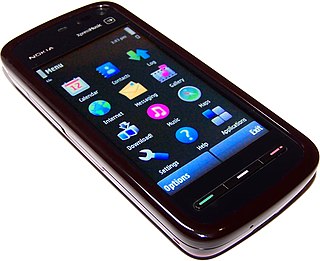
Nokia 5800 XpressMusic is a smartphone part of the XpressMusic line, announced by Nokia on 2 October 2008 in London and started shipping in November of that year. Code-named "Tube", it was the first touchscreen-equipped S60 device by Nokia – essentially it was the first device to run Symbian^1, also known as S60 5th Edition, the touch-specific S60-based platform created by the Symbian Foundation. The touchscreen features tactile feedback.
Nokia's strategic nomenclature can be traced back in 2005 when the Nseries line was launched, offering devices with flagship specifications and premium hardware at various price points. These devices were considered the "bread and butter" of the company and were often positioned to showcase their latest technologies. Thanks to the newfound consumer and enterprise interest in smartphones at the time, the company introduced four additional collections to diversify their product portfolio and meet demands in most market segments. These new phone series were named Eseries, targeting small business and enterprise customers; Xseries, providing consumer-grade multimedia-focused devices; Cseries, which Nokia used to target both the low-end and mid-range market segments; and Tseries, for devices exclusive to the Chinese market.
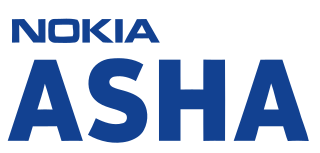
The Nokia Asha 200 & Nokia Asha 201 are budget-level additions to the Nokia Asha family released in Q4 2011. Both devices run the Nokia S40 mobile operating system. There is no direct predecessor of the phones, though the closest to it is the Nokia X2-01, which has similar features and a very similar user interface, as well as having better music capabilities. The Nokia C3 is also an indirect predecessor, also using similar features, though the C3 is a higher end device. The phones are successors to the Nokia X1-01, as they use the same bright colors and the same Dual SIM support for Nokia Asha 200.

The Nokia Lumia 1020 is a smartphone developed by Nokia, first unveiled on 11 July 2013 at a Nokia event in New York. It runs Windows Phone 8, but is also Windows Phone 8.1 ready. It contains Nokia's PureView technology, a pixel oversampling technique that reduces an image taken at full resolution into a lower resolution picture, thus achieving higher definition and light sensitivity, and enables lossless digital zoom. It improves on its predecessor, the Nokia 808, by coupling a 41-megapixel 2/3-inch BSI sensor with optical image stabilization (OIS) and a high resolution f/2.2 all-aspherical 1-group Carl Zeiss lens. It was considered to be the most advanced cameraphone when released in September 2013.
